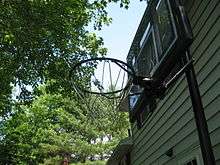Backboard (basketball)


A backboard is a piece of basketball equipment. It is a raised vertical board with a basket attached. It is made of a flat, rigid piece of material, often Plexiglas or tempered glass which also has the properties of safety glass when accidentally shattered. It is usually rectangular as used in NBA, NCAA and international basketball. In recreational environments, a backboard may be oval or a fan-shape, particularly in non-professional games.
Today most professional backboards are made of a glass backboard so that it will not obstruct the audience's view, although most non-professional backboards are made from something that may obstruct the audience's view, such as goals at parks or on streets.
A basketball hoop is mounted to a basketball backboard via a flexible connection between the backboard and the connection supporting the hoop. The shock of a basket or a dunk is absorbed by the connecting part, so that the rim goes back to a horizontal position once again.
The top of the hoop is 10 feet (305 cm) above the ground. Regulation backboards are 72 inches (183 cm) wide by 42 inches (110 cm) tall. All basketball rims (hoops) are 18 inches (46 cm) in diameter. The inner rectangle on the backboard is 24 inches (61 cm) wide by 18 inches (46 cm) tall.[1]
The first glass backboard was used by the Indiana Hoosiers men's basketball team at the Men's Gymnasium at Indiana University.[2] After the first few games at their new facility in 1917, spectators complained that they couldn't see the game because of opaque wooden backboards. As a result the Nurre Mirror Plate Company in Bloomington was employed to create new backboards that contained 1 1⁄2-inch (3.8 cm) plate glass so that fans could see games without an obstructed view. It was the first facility in the country to use glass backboards.[2]
Uses
| Wikimedia Commons has media related to Basketball goals. |
Backboards can be used in areas such as parks, backyards, rooms and courts. However, not all hoops will have backboards.[3]
References
- ↑ http://www.nba.com/analysis/rules_1.html Oct 17 2006 4:32AM
- 1 2 Hiner, Jason (2005). Indiana University Basketball Encyclopedia. United States: Sports Publishing. p. 447. ISBN 1-58261-655-8.
- ↑ Playing Basketball without a Backboard. Retrieved November 2013. Check date values in:
|access-date=(help)